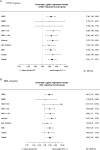The relationship between ventricular electrical delay and left ventricular remodelling with cardiac resynchronization therapy
- PMID: 21875862
- PMCID: PMC3195261
- DOI: 10.1093/eurheartj/ehr329
The relationship between ventricular electrical delay and left ventricular remodelling with cardiac resynchronization therapy
Abstract
Aims: The aim of the present study was to evaluate the relationship between left ventricular (LV) electrical delay, as measured by the QLV interval, and outcomes in a prospectively designed substudy of the SMART-AV Trial.
Methods and results: This was a multicentre study of patients with advanced heart failure undergoing cardiac resynchronization therapy (CRT) defibrillator implantation. In 426 subjects, QLV was measured as the interval from the onset of the QRS from the surface ECG to the first large peak of the LV electrogram. Left ventricular volumes were measured by echocardiography at baseline and after 6 months of CRT by a blinded core laboratory. Quality of life (QOL) was assessed by a standardized questionnaire. When separated by quartiles based on QLV duration, reverse remodelling response rates (>15% reduction in LV end systolic volume) increased progressively from 38.7 to 68.4% and QOL response rate (>10 points reduction) increased from 50 to 72%. Patients in the highest quartile of QLV had a 3.21-fold increase (1.58-6.50, P = 0.001) in their odds of a reverse remodelling response after correcting for QRS duration, bundle branch block type, and clinical characteristics by multivariate logistic regression analysis.
Conclusion: Electrical dyssynchrony, as measured by QLV, was strongly and independently associated with reverse remodelling and QOL with CRT. Acute measurements of QLV may be useful to guide LV lead placement.
Figures




References
-
- Cazeau S, Leclercq C, Lavergne T, Walker S, Varma C, Linde C, Garrigue S, Kappenberger L, Haywood GA, Santini M, Bailleul C, Daubert JC. Effects of multisite biventricular pacing in patients with heart failure and intraventricular conduction delay. N Engl J Med. 2001;344:873–880. doi:10.1056/NEJM200103223441202. - DOI - PubMed
-
- Abraham WT, Fisher WG, Smith AL, Delurgio DB, Leon AR, Loh E, Kocovic DZ, Packer M, Clavell AL, Hayes DL, Ellestad M, Trupp RJ, Underwood J, Pickering F, Truex C, McAtee P, Messenger J. Cardiac resynchronization in chronic heart failure. N Engl J Med. 2002;346:1845–1853. doi:10.1056/NEJMoa013168. - DOI - PubMed
-
- Bristow MR, Saxon LA, Boehmer J, Krueger S, Kass DA, De Marco T, Carson P, DiCarlo L, DeMets D, White BG, DeVries DW, Feldman AM. Cardiac-resynchronization therapy with or without an implantable defibrillator in advanced chronic heart failure. N Engl J Med. 2004;350:2140–2150. doi:10.1056/NEJMoa032423. - DOI - PubMed
-
- Cleland JG, Daubert JC, Erdmann E, Freemantle N, Gras D, Kappenberger L, Tavazzi L Cardiac Resynchronization-Heart Failure (CARE-HF) Study Investigators. The effect of cardiac resynchronization on morbidity and mortality in heart failure. N Engl J Med. 2005;352:1539–1549. doi:10.1056/NEJMoa050496. - DOI - PubMed
-
- Linde C, Abraham WT, Gold MR, St John Sutton M, Ghio S, Daubert C REVERSE (REsynchronization reVErses Remodeling in Systolic left vEntricular dysfunction) Study Group. Randomized trial of cardiac resynchronization in mildly symptomatic heart failure patients and in asymptomatic patients with left ventricular dysfunction and previous heart failure symptoms. J Am Coll Cardiol. 2008;52:1834–1843. doi:10.1016/j.jacc.2008.08.027. - DOI - PubMed
Publication types
MeSH terms
LinkOut - more resources
Full Text Sources
Other Literature Sources
Medical
Research Materials

